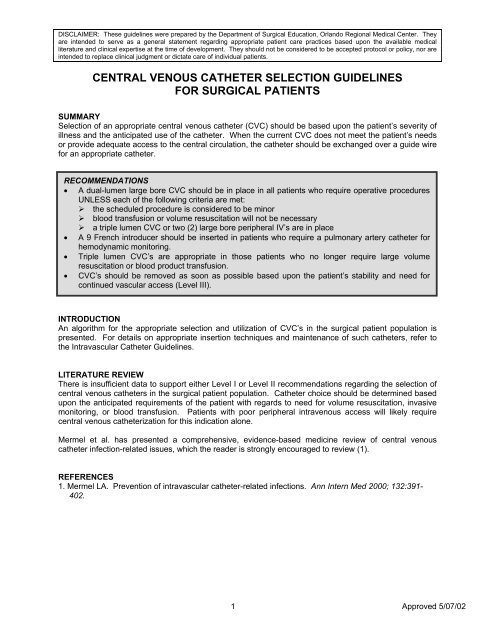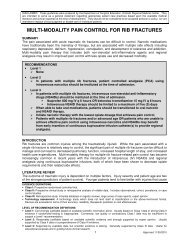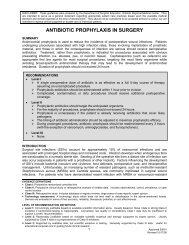central venous catheter selection guidelines for surgical patients
central venous catheter selection guidelines for surgical patients
central venous catheter selection guidelines for surgical patients
You also want an ePaper? Increase the reach of your titles
YUMPU automatically turns print PDFs into web optimized ePapers that Google loves.
DISCLAIMER: These <strong>guidelines</strong> were prepared by the Department of Surgical Education, Orlando Regional Medical Center. Theyare intended to serve as a general statement regarding appropriate patient care practices based upon the available medicalliterature and clinical expertise at the time of development. They should not be considered to be accepted protocol or policy, nor areintended to replace clinical judgment or dictate care of individual <strong>patients</strong>.CENTRAL VENOUS CATHETER SELECTION GUIDELINESFOR SURGICAL PATIENTSSUMMARYSelection of an appropriate <strong>central</strong> <strong>venous</strong> <strong>catheter</strong> (CVC) should be based upon the patient’s severity ofillness and the anticipated use of the <strong>catheter</strong>. When the current CVC does not meet the patient’s needsor provide adequate access to the <strong>central</strong> circulation, the <strong>catheter</strong> should be exchanged over a guide wire<strong>for</strong> an appropriate <strong>catheter</strong>.RECOMMENDATIONS• A dual-lumen large bore CVC should be in place in all <strong>patients</strong> who require operative proceduresUNLESS each of the following criteria are met:‣ the scheduled procedure is considered to be minor‣ blood transfusion or volume resuscitation will not be necessary‣ a triple lumen CVC or two (2) large bore peripheral IV’s are in place• A 9 French introducer should be inserted in <strong>patients</strong> who require a pulmonary artery <strong>catheter</strong> <strong>for</strong>hemodynamic monitoring.• Triple lumen CVC’s are appropriate in those <strong>patients</strong> who no longer require large volumeresuscitation or blood product transfusion.• CVC’s should be removed as soon as possible based upon the patient’s stability and need <strong>for</strong>continued vascular access (Level III).INTRODUCTIONAn algorithm <strong>for</strong> the appropriate <strong>selection</strong> and utilization of CVC’s in the <strong>surgical</strong> patient population ispresented. For details on appropriate insertion techniques and maintenance of such <strong>catheter</strong>s, refer tothe Intravascular Catheter Guidelines.LITERATURE REVIEWThere is insufficient data to support either Level I or Level II recommendations regarding the <strong>selection</strong> of<strong>central</strong> <strong>venous</strong> <strong>catheter</strong>s in the <strong>surgical</strong> patient population. Catheter choice should be determined basedupon the anticipated requirements of the patient with regards to need <strong>for</strong> volume resuscitation, invasivemonitoring, or blood transfusion. Patients with poor peripheral intra<strong>venous</strong> access will likely require<strong>central</strong> <strong>venous</strong> <strong>catheter</strong>ization <strong>for</strong> this indication alone.Mermel et al. has presented a comprehensive, evidence-based medicine review of <strong>central</strong> <strong>venous</strong><strong>catheter</strong> infection-related issues, which the reader is strongly encouraged to review (1).REFERENCES1. Mermel LA. Prevention of intravascular <strong>catheter</strong>-related infections. Ann Intern Med 2000; 132:391-402.1 Approved 5/07/02
Surgical, trauma,or burn patientYesVascular accessnecessary?NoRemove allintra<strong>venous</strong> linesCATHETER CHOICEIs patientgoing to OR*?Is volume resuscitationor blood transfusionlikely?NoIs right heart<strong>catheter</strong>necessary?NoYesYesDouble-lumen largebore <strong>central</strong> <strong>venous</strong><strong>catheter</strong>9F Introducer** For <strong>patients</strong> requiring surgery **Large bore <strong>central</strong> <strong>venous</strong> <strong>catheter</strong>sare necessary <strong>for</strong> any patient whomay require volume resuscitation orblood transfusion while in theoperating room.Patients scheduled <strong>for</strong> suchprocedures should have a dual-lumenlarge bore <strong>central</strong> <strong>venous</strong> <strong>catheter</strong> inplace prior to going to the operatingroom.For <strong>patients</strong> scheduled to undergo"minor" operative procedures withminimal risk <strong>for</strong> blood loss orhemodynamic instability, triple lumen<strong>catheter</strong>s are acceptable.Is patient inresuscitationphase?YesDouble-lumen largebore <strong>central</strong> <strong>venous</strong><strong>catheter</strong>NoIs peripheralaccess feasible?NoTriple lumen <strong>catheter</strong>YesPeripheral IV <strong>catheter</strong>2 Approved 5/07/02
















